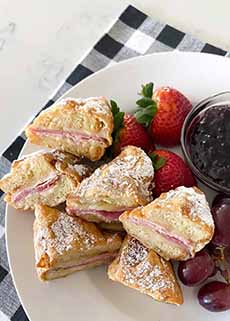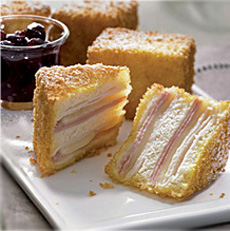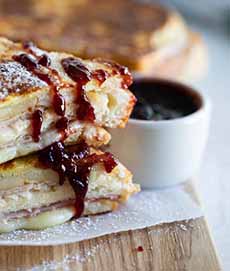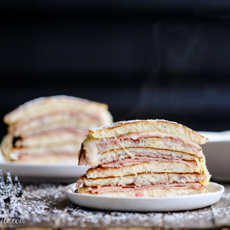|
September 17th is National Monte Cristo Day, celebrating a sandwich that some people consider to be a fancy grilled ham and cheese sandwich on French toast. Actually, it’s the American adaptation of the Croque Monsieur, a French grilled ham and cheese sandwich on French toast.
> The Monte Cristo recipe is below.
> The year’s 27+ sandwich holidays.
> The history of the Monte Cristo sandwich is below.
> The history of the sandwich.
> The different types of sandwiches: a photo glossary.
> The different types of bread: a photo glossary.
MONTE CRISTO, CROQUE MONSIEUR & CROQUE MADAME: THE DIFFERENCE
Croque Monsieur Sandwich is a hot sandwich made with Bayonne ham (French ham) and Gruyère cheese on pain de mie (a white bread with a bit of the sweetness of brioche). The original was topped with béchamel sauce and some grated cheese, then baked in the oven (photo #7).
Today, especially in the U.S., a Croque Monsieur can be dipped in a beaten egg with milk and then sautéed in butter. The bread portion becomes French toast.
Some cooks still use the old French recipe, but grill the sandwich instead of baking it in the oven, and then put under the broiler. Instead of béchamel, they use a cheese sauce, which in France is called mornay sauce—béchamel turned into cheese sauce with the addition of Gruyère. In the U.S., the cheese of choice is often Cheddar.
Croque Madame Sandwich. The Croque Madame (photo #6) wasn’t created for the ladies; it was so-called because it resembles a woman’s hat (photo #9). It’s similar to a Croque Monsieur with a poached or fried egg on top. We don’t know when it was first created, but the name itself dates to around 1960 [source].
Monte Cristo Sandwich is a variation made with white bread, ham and Gruyère, although some recipes substitute Gouda or other cheese. It has a sweet-and-savory profile: The sandwich is dipped in a French toast batter (eggs and milk), then pan-fried or deep-fried. It’s served with a side of grape jelly for dipping (or blackberry if you can find it), and often a dusting of powdered sugar (photo #1).
Some cooks make a three-layer Monte Cristo, some add turkey. Here’s a copycat recipe of the Disneyland recipe (photo #1) and a copycat of the Bennigan’s recipe, which uses pancake batter (photo #3).
Think outside the box. How about using pancakes instead of bread (photo #5)? How about some peanut butter (photo #6). How about some bacon? How about some sliced tomatoes with that ham and cheese?
By the way: These sandwiches are best eaten with a fork and knife.
HISTORY OF THE CROQUE MONSIEUR SANDWICH & THE MONTE CRISTO
The origin of the Croque Monsieur is not known with certainty, but it is believed to have originated in French bistros and cafés as a quick snack. The name means a, roughly, “a bite for a man,” from French words croque (bite) and monsieur (“mister”).
One of the first known written references is on Parisian menu from 1910. It is cited in volume 2, Within a Budding Grove (published 1918), of Marcel Proust’s epic novel, In Search of Lost Time [source].
When there is no certainty, there are always apocryphal stories.
The radiator. Some French workers left their lunches too close to a radiator. The heat melted the cheese and toasted the bread and the sandwich was born.
The lack of baguette. A Parisian chef of a brasserie on the Boulevard des Capucines invented the sandwich one day in 1901, after running out of baguettes for the restaurant’s sandwich of the day. He took a loaf of pain de mie (similar to an American pullman loaf), sliced it, placed ham and cheese between the slices, buttered it and cooked it to crispiness. When a customer asked about the ingredients, the chef pointed to another customer, the butcher, and said “C’est la viande de monsieur” (It’s that man’s meat) [source].
Both the Croque Monsieur and Croque Madame remain popular lunchtime staples in France [source].
In recent years, different chefs and restaurants have put their own spins on the original Croque Monsieur recipe. See them below
Decades later came the Monte Cristo sandwich.
No one knows exactly who created it and named it, but it happened somewhere in California. It was popularized by California cafés in the 1950s, where it first appeared on a menu as The Monte. It became a menu favorite at the Disneyland in Anaheim, California, at the Cafe Orleans in New Orleans Square [source].
Today it’s on the menu as “Battered & Fried Cheese ‘Monte Cristo’ [served with Brie, Swiss and Mozzarella with Pommes Frites.”
Some say that “Monte Cristo” is a tribute to the French novel, The Count of Monte Christo by Alexander Dumas. Hmmm. It was originally called the Monte, which can refer to a card game, a mountain, or something else entirely.
There is a real Montecristo, by the way; a beautiful island in Tuscan Archipelago (west of Tuscany, Italy in the Tyrrhenian Sea, which flows into the Mediterranean.
Alexandre Dumas also built the Chateau de Monte-Cristo in Port-Marly, now a museum (photo #10). And there’s luxury Hôtel Monte Cristo in Paris, both a inspired by his famous novel. While the island of Montecristo is a real Mediterranean location
Back to the food:
The traditional Monte Cristo sandwich is made from deli ham and Swiss cheese. The entire sandwich is then lightly dipped in the egg batter used for French Toast, and grilled or deep fried.
RECIPE: MONTE CRISTO SANDWICH
The sandwich is served with a side of jelly for dipping, and often garnished with powdered sugar. We’re not a fan of the latter. It just gets over everything (table and clothes). And who needs sugar on a ham and cheese?
While we prefer Gruyère cheese, as is used in the Croque Monsieur and Croque Madame, you can substitute Emmental, or America’s approximation of Emmental, a.k.a. Swiss cheese—or whatever you like. We’ve seen everything from Gouda to Provolone.
TIP: You can hold the sandwich layers with with toothpicks. Add them before battering and frying.
Ingredients For 4 Sandwiches
8 slices quality white bread or brioche
8 slices ham
8 slices turkey
8 slices Gruyère or substitute
2 eggs
1/2 cup milk or more (depending on how thick you want the batter)
Optional for the batter: dash nutmeg
Butter for frying
For Serving
Grape jelly, or blackberry or raspberry jelly or jam, for dipping
Powdered sugar for garnish
Preparation
1. WHISK the eggs and milk in a shallow pan. Melt the butter in a large skillet.
2. LAYER a slice of bread, cheese, ham, another slice of bread spread with mayonnaise, turkey, cheese, and then another slice of bread. Cut or fold the meats and cheese so they are contained within the borders of the bread. Press down so that the layers stick together, and use toothpicks to hold them.
3. MELT the butter in the skillet. Dip each sandwich in the milk and egg mixture, then transfer to the skillet. Cook until the bread is toasted on both sides and the cheese is melted.
4. CUT in half. Dust with powdered sugar if desired, and with the jelly/jam in a ramekin on the side.
CROQUE VARIATIONS
Up-and-coming chefs and restaurants can gain attention by putting their own twist on classic dishes. Common variations on the Croque Monsieur, listed in Wikipedia include:
Croque Auvergnat*, made with bleu d’Auvergne cheese.
Croque Bolognese, which adds Bolognese sauce (tomato sauce with ground meat—also commonly called the Croque Boum-Boum).
Croque Gagnet†, made with Gouda cheese and andouille sausage (photo #8).
Croque Hawaiian, with a slice of grilled pineapple.
Croque Norvégien, made with smoked salmon instead of ham.
Croque Poulet, which replaces the ham with grilled chicken.
Croque Provençal, which includes a slice of tomato.
Croque Señor, which adds salsa.
Croque Tartiflette‡, which uses Reblochon cheese and adds sliced potatoes.
…and of course, the Croque Madame, previously described.
That’s a lot of croque for you to consider. You may like to create your own. We often make one with chicken and truffle cheese.
|
|

[1] A Monte Cristo with ham, cheese, turkey, powdered sugar and grape jelly. Here’s the recipe (photo © Picky Palate).

[2] Kikkoman also adds turkey to the ham and cheese, makes it a triple decker, and dips the battered sandwich into crunchy panko bread crumbs. Here’s the recipe (photo © Kikkoman).

[3] Bennigan’s dips their Monte Cristo in pancake batter. Here’s the recipe (photo © I Am A Homesteader).

[4] It wouldn’t be a Monte Cristo without the dipping jelly. Here’s another recipe (photo © Taste And Tell Blog).

[5] Krusteaz thinks outside the box and makes a Monte Cristo with pancakes instead of bread (photo © Krusteaz).

[6] Another variation: a slick of peanut butter on the bread (photo © Peter Pan).

[7] The original Croque Monsieur was baked in the oven with béchamel sauce and grated Gruyère. Here’s the recipe from Chef Michel Roux (photo © The Good Life France).

[8] Croque Gagnet, a variation of Croque Monsieur made with Gouda cheese and andouille sausage. Here’s the recipe. See more variations (photo © Cambooza).

[9] The Croque Madame: a ham and cheese sandwich topped with a fried or poached egg (photo © Adam Bartoszewicz | Unsplash).

[10] The Château de Monte Cristo. Here’s more about it (photo CC By SA 3.0).
|












